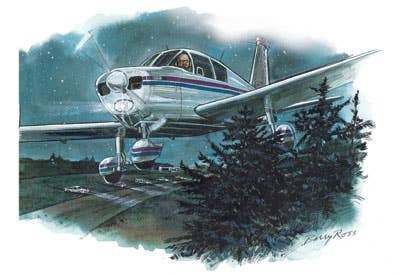
I was flying a Piper Cherokee 180, one I had rented and flown many times before. Outbound, I had flown alone from Seattle to an airstrip at Sekiu, Washington. The airstrip serves a tiny fishing village along the north coast of the Olympic Peninsula 150 miles west of Seattle. Although I had landed in daylight, I was attending a meeting that I knew would probably not be over till evening. That meant a night takeoff for the return trip. I also expected to be carrying two passengers with me. The year was 1975, but the lessons learned are timely today.
I had a private pilot license, single-engine land, but no instrument rating. I had accumulated about 500 hours, including instruction in night flying and about 13 hours of night flight. I considered myself a prudent pilot, inclined to plan carefully for each flight and any challenges it posed. The field from which I would be taking off did pose serious challenges. At the time, the runway was an unpaved clearing atop a hill, without any lights at the field at all. The runway ran east and west. Along the north side of the runway was a forest of tall Douglas firs, about 200 feet from the edge of the runway. The runway was not level and had a hump about a third of the way to the end. I was concerned about the darkness of the field, but my friends said they would line up their trucks along the field, shining their headlights across the runway. I thought (foolishly as it turned out) that I could use these lights to guide me during my takeoff run.
The field dropped away steeply at the end of the runway and there were no obstacles beyond the field. All I had to do was gain flying speed and begin my climb before nearing the end of the runway. It was a clear, starlit night and I felt confident that once I was airborne, everything would be routine. I mentally reviewed all the factors; weight and balance - there were three of us aboard without luggage, only briefcases - fuel checked visually, more than half a tank, chart reviewed and course planned. After a careful preflight inspection, I got in, loaded my passengers and prepared for the takeoff.
As I lined up with the runway, I could clearly see the headlights of the trucks parked alongside and confidently opened the throttle. I was a little tense and very alert, prepared to handle the bumpy ride to take off. Then things started to happen that I was not prepared for. As we gathered speed and approached the headlights, the cowling obstructed my view of the headlights and soon I was without any guiding lights. At about that moment we roared over the hump and the airplane became airborne when we had barely attained flying speed. The red stall warning light was flashing on and off. I lowered the nose to gain airspeed, hoping that I was well clear of the trees off to my left. But a sixth sense told me that I was dangerously close to them, even though I could not see them. I gingerly banked away from the trees, trying to avoid a steep bank for fear of stalling. It was a juggling act, keeping the nose down to build speed while lifting the left wing into a shallow bank. My heart was pounding in the few seconds this took and I prayed we would clear the trees. We did, but not without the left landing gear flicking through the tree tops. Then we were aloft and climbing safely to cruising altitude.
Only then did I become aware that the field was sheltered from the winds by the trees alongside it, and as I became airborne the airplane began to drift left because of southerly crosswind. In daylight, I could have easily corrected, but at night, without any visual guides, I had no awareness of the drift. A few feet lower and we would have caught a tree limb and crashed. As it was, we cleared the tree tops by only a foot or two.
My instincts had served me well, but my judgment had been terrible. I had overlooked the possibility of a crosswind, I had misjudged the effect of the hump in the field and I had foolishly assumed that truck headlights could substitute for runway lights. I was humbled by the experience. Today the strip is paved and lit and even lengthened. But because of its location at the top of a steep hill, it is a field that must still be approached with care. As for me, while I had other adventures flying, I never made this mistake again. Taking off from an unpaved, unlit strip at night is a highly risky undertaking, especially for an inexperienced pilot.

Sign-up for newsletters & special offers!
Get the latest FLYING stories & special offers delivered directly to your inbox






